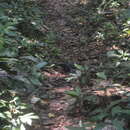en
names in breadcrumbs


The black roughneck monitor (Varanus rudicollis) is a species of monitor lizard found in Southeast Asian countries of Thailand, Burma, and Malaysia. It is also found in Indonesia on Sumatra and islands of the Riau Archipelago[4] It is sometimes known simply as the roughneck monitor.[5] In Thailand is called h̄èā cĥāng (Thai: เห่าช้าง; "elephant bark").[6]
The habitat of Varanus rudicollis is limited to primary and secondary rainforest and mangrove swamps.[7] In the wild the black roughneck monitor is very rarely seen, but whether this is because of its rarity or its very secretive behavior is uncertain.[3] They are often kept successfully in captivity, but have a shy disposition.[3][8]
The black roughneck is a medium to large monitor. It usually reaches an average adult size of 3–4 ft. (90–120 cm), with a maximum length of 5 feet (150 cm), reported.[8] The black rough-necked monitor can be easily recognized by large pointed scales adorning the necks of adults.[4] They are a gracile, long-bodied lizard with a prominently pointed snout. There are two species known as roughnecked monitors, black roughnecks and brown roughnecks. The black roughnecks, when young, have various markings to better camouflage amongst leaf litter. As they age, the colors fade into primarily black or dark gray. They are arboreal, diurnal and feed on mainly insects as well as frogs, small mammals, reptiles and fish. The brown roughneck, also called the Dumeril's monitor is in comparison a specialized shellfish feeder. They have similar markings to black roughnecks when young, but when older fade to a brown color, as their name implies. Both black and brown roughnecks are known for their very calm temperament, rarely biting or tail whipping in captivity. When threatened they prefer to escape, urinate or defecate, puff up their throats or “go necrotic” by closing their eyes as if playing dead.
The known lifespan of black roughneck monitor is about 10–20 years in captivity.[8]
The black roughneck monitor (Varanus rudicollis) is a species of monitor lizard found in Southeast Asian countries of Thailand, Burma, and Malaysia. It is also found in Indonesia on Sumatra and islands of the Riau Archipelago It is sometimes known simply as the roughneck monitor. In Thailand is called h̄èā cĥāng (Thai: เห่าช้าง; "elephant bark").
The habitat of Varanus rudicollis is limited to primary and secondary rainforest and mangrove swamps. In the wild the black roughneck monitor is very rarely seen, but whether this is because of its rarity or its very secretive behavior is uncertain. They are often kept successfully in captivity, but have a shy disposition.